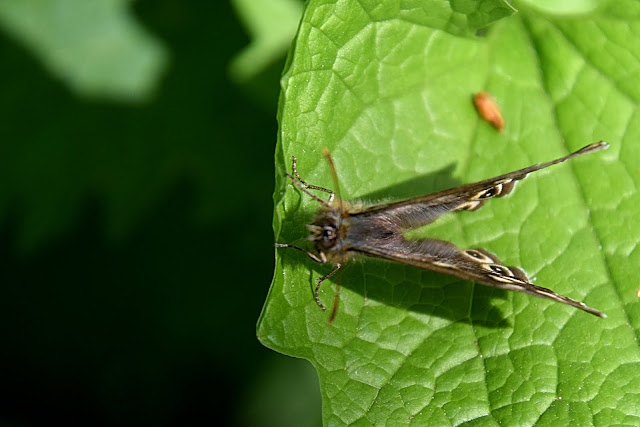Twenty second of April's pics
Feeding
Speckled wood
Orange tip

Terrapin
Where, you might ask, do these beasts come from?
There are a few species of terrapins that are present in our waterways. The most common is the red-eared terrapin, which although originally native to Britain around 8,000 years ago has returned, transported from the USA as pets during the Teenage Mutant Hero Turtles cartoon craze of the 1980s.
Today, these pets have grown to the size of a dinner plate and developed enough strength to break free of their tanks. Their subsequent, and irresponsible, release into the wild has prompted fears for the health of local wildlife, as well as the terrapins themselves who are ill-equipped to survive in the damp British climate.
Terrapins, along with tortoises and turtles, are known as Chelonians - reptiles with shells. They are almost totally aquatic but also need dry land to bask on during sunny days. Still waters and rivers in the Midlands and Southern England support the largest terrapin populations. Snapper turtles and European pond terrapins have also been spotted along our waterways.
It is unlikely that these animals are breeding, as terrapin eggs need to be incubated at 25 degrees Celsius for around 60 days in order to hatch. Anyone familiar with the British summer knows exactly how unlikely that is. However, with climate change there is concern they could start breeding and cause more damage.

She sits

Hawthorn blossom
Ne'er cast a clout 'til may be out.
Apparently the consensus of opinion of the interpretation of this phrase is that you shouldn't discard winter clothing until the month of May*.
I dislike like this and incline to the view that such clothing might be discarded when the hawthorn blooms its
'may blossom'.
Actually may blossoming and May aren't sofar apart so it's probably rather moot.

Not sure what this blossom is.
Anyone?



The newest nest under construction

Rowan leaves
Looking almost intentionally beautiful.

The rugby field from the western end

Beeflies
(there are two here)



Alder leaf beetles mating

Green, white, yellow and blue.

Blackbird on a fence


Big (top) and small turtles
April the Twentythird

Back garden bee

My two favourite ducks

Greylag doing flamingo impression

A face that only a mother could love

Speckled wood

Head

At the new nest

Yellow

Orange tip
The Orange-tip is a true sign of spring, being one of the first species to emerge that has not overwintered as an adult. The male and female of this species are very different in appearance. The more-conspicuous male has orange tips to the forewings, that give this butterfly its name. These orange tips are absent in the female and the female is often mistaken for one of the other whites, especially the Green-veined White or Small White. This butterfly is found throughout England, Wales and Ireland, but is somewhat-local further north and especially in Scotland. In most regions this butterfly does not form discrete colonies and wanders in every direction as it flies along hedgerows and woodland margins looking for a mate, nectar sources or foodplants.

Molehills: the moles have been busy on the rugby field

Might have done enough pics of ducklings now

I was told t'other day that she was sitting on eight eggs.
Fertile, ain't she?

The smaller turtle's found a new basking place

Coot and turtle sharing a log

And a speckled wood to finish the day
November the first 2019
November is the 11th month of the year in the modern day Gregorian calendar and its predecessor, the Julian calendar. The month kept its original name from the Latin novem meaning “nine” which marked it the 9th month of the year in the Roman calendar.
November was named during a time when the calendar year began with March, which is why its name no longer corresponds with its placement in the Julian and Gregorian calendars.
Middle English - novembre
Latin name - novembris mensis - 9th month
Old English - Blotmanad - Blood month
November’s birth flower is the chrysanthemum.
The birthstone for November is the topaz.

Robin about to depart

Lichen

Lunch
Handsome
Stepping out
A rubbery mushroom known as Auricularia auricula-judae or Jew’s ear.
The term “Jew’s ear” might make you feel funny, but it was not intended to be anti-Semitic. It’s more about the fact that these tasty mushrooms look a lot like wrinkly ears and are most often found on the wood of elder trees. Lest you forget your Christian gospel, Judas Iscariot hanged himself on an elder tree after he betrayed Jesus Christ.
Linnaeus, the “father of modern taxonomy,” named these fungi Tremella auricula back in 1753. But as binomial nomenclature expanded, these chewy treats got renamed. In 1880, a mycologist named Joseph Schroter started calling this fungus “Judas’s ear.” It soon got shortened to “Jew’s ear.” After all, Judas was a Jew.
As far as fungi go, it’s actually a pretty amazing species. It’s been used in folk medicine to treat sore throats, eye infections and jaundice. Today it is still used in Chinese medicine and as a blood tonic in Ghana. Research in the 1980’s showed A. auricula-judae medicinal attributes include slowing tumors, controlling blood sugar levels, preventing blood clots, and lowering cholesterol.
This one is rather unusual as it's growing on a canalside
willow tree.

Leaf
Thrid of November
Mossy
I thought that this fungus was called 'dead man's fingers', but all the references say that it is dark or even black so ..























































